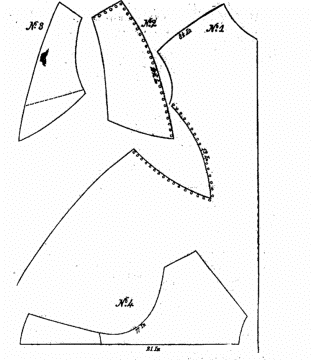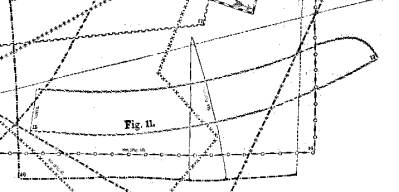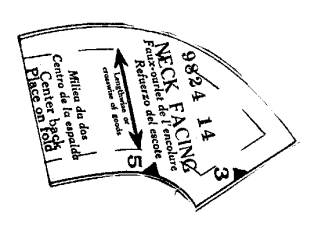The Evolution of Dressmaking Patterns in the United States
Arlesa Shephard
Ashland University
Abstract
The purpose of my study was to determine how home dressmaking patterns evolved through the years in the United States, from early patterns through today. My research showed that home dressmaking patterns began in women�s periodicals during the 1850s and survived three main stages of evolution. Approximately 30 patterns were used for the research, which averages two patterns per decade. Home dressmaking patterns underwent many changes, from their original small-scale beginning, for the benefit of the consumer and the solution that has proved to be the most beneficial and long-standing is the packaged pattern.
Introduction
With the returnof fashions from the past and the use of patterns in costuming, it is important to understand how early patterns were used and how they have evolved into the patterns that are familiar to current sewers. The purpose of the study was to determine how home dressmaking patterns evolved through the yearsin the United States, from early patterns through today.
Commercial patterns have changed considerably since their early years in the mid-1800s. Several documents exist that discuss patterns from specific time periods or decades, for example, Laboissonniere�s book written in 1997 about packaged patterns from the 1940s and Grimble�s book called The Edwardian Modiste: 85 Authentic Patterns with Instructions, Fashion Plates, and Period Sewing Techniques in 1997. Little research has been conducted, however, to connect the overall evolution of these patterns and what promoted their evolution. The objective of this study was to track the overall evolution of home dressmaking patterns and show how commercial patterns of today evolved from their early years. Although many books and articles discuss different decades of patterns, none were found that looked at their evolution as a whole. This researcher�s intention was to determine how patterns have changed and what the possible causes were for those changes.
Limitations of the Study
One of the main limitations of thisstudy was the lack of availability of authentic older patterns. Because the patterns were made out of tissue, which is not a sturdy substance, patterns have disintegrated, become lost, or discarded. Many of the early women�s periodicals are now on microfilm and because of thelarge dimensions of the pattern supplements, they were simplyeither notretained with the periodicalor notaddedonto the microfilm. Packaged patternswere also difficult to find from the 1800s because there were not very many in circulationduring their early years and they werevery delicate and easilydestroyed. The early packaged patterns weremade of tissue paper and kept in fragile paper envelopes, both of which have long since disintegrated. Another limitationwas that with packaged patterns, many companies did not use copyright dates. Even when copyright dates were used, it was stilldifficult to tell the true life of the pattern. The datedidnot indicate how long the pattern was for sale or when it was popular.
Procedure
Sample
Approximately 30 patterns were used in this research. Twodress patterns were studied from each decade, starting in the 1850s, to illustrate the evolution of dress patterns chronologically. Using two patterns from each decade created consistency so that overall comparisons between the decades could be made.
Instrument
Data collection sheets were developed by the researcher to record information. These sheets were used to write notes that could later be used to assist in the comparison process. Using data collection sheets helped focus and organize the information collected from the patterns.
Data Collection Method
In order to collect the data, patternschosen from the researcher�s personal collection, patterns from the Kent State University Museum�s collection, and patterns from microfilm and reprints of the women�s periodicals from Ohio State University, Case Western Reserve University, and Kent State Universitywere studied. The data for this research were collected between the months of September and November, 2002.
Data Analysis
Conclusions were drawn by comparing and contrasting the information on the data collection sheets. By collecting patterns using historical research, the researcher was able to interpret how and why patterns changed.
Results and Discussion
To better understand the history of why home dressmaking patterns began, research was done to find out what affect sewing machines and dressmakers had on the arrival of patterns. Elias Howe created the first successful sewing machine in 1846 that was used in the manufacturing process for such items as corsets and umbrellas. Isaac Singer, however, was the man responsible for creating a machine that was suited for home use in 1858 (Cooper, 1976). Until the development of practical sewing machines, tailors and seamstresses were responsible for making quality garments, often by using the draping method. It was not until the 19th Century that several dressmakers patented pattern-drafting systems (Grimble, 1997).
As a result of the research, it was found that the overall evolution of home dressmaking patterns could be classified in three stages. The first stage ranged from the 1850s to the 1870s and was the beginning of home dressmaking patterns. The first patterns could be found only in women�s journals and were drawn insmall-scale with few instructions (Fernandez, 1987). Small-scale patterns did exist in some women�s journals through the turn of the century, but they evolved into tips rather than original patterns. The tips were mostly on how to alter a standard dress patterns to fit the current styles. By the 1870s instructions had improved greatly, but the small-scale patterns became scarce as the popularity of pattern supplements grew.
Figure 1 - Early Dress Pattern from Peterson�s Magazine, January 1857
The second stage, pattern supplements forced the small-scale patterns to become obsolete and was found in magazines from the late 1860�s to the turn of the 20th century. These patterns were a success because they were full-scale and women no longer had to confuse themselves with the many methods used to enlarge patterns. The problem with pattern supplementswas that they were full-scale andprinted on one sheet of paper causing pattern piecesto overlap which required tracing (Grimble, 2001). These patterns were often so difficult to trace that pattern companies were forced to look for alternative methods. The alternative theydevised wasthe packaged patterns.
Figure 2 - Collar Pattern (Fig. 11) in a Pattern Supplement from Harper�s Bazaar, December 17, 1870
In the third stage of pattern evolution beginning in the 1880s, magazines began to offer packaged patterns, but their true success occurred around the turn of the century when magazines stopped offering pattern supplements (Fernandez, 1987). The probable reason for this was because even though pattern supplements were often difficult to use, women preferred taking the time to trace the pattern in their possession as opposed to paying the shipping and waiting for a packaged pattern. Once a large range of patterns began to be offered in magazines, women realized the value and convenience of having patterns precut totheir sizes. In the beginning, the packaged patterns either did not have instruction sheets or had an instruction sheet that gave only minimal instructions. It took several decades to improve instruction sheets to the point where they used simple enough descriptions for everyone, including many non-sewers, to understand.��
Although packaged patterns are still used today, manufacturers have made many improvements over the years. One improvement to patterns was printed pattern pieces. Prior to printed pattern pieces, patterns were created out of pre-cut tissue with the construction details shown on the pattern pieces through perforation. McCall�s began the printing method in the late 1920s, but it did not reach most of the other pattern companies until the 1960s due to copyright laws (Laboissonniere, 1997). The most recent improvement was in the 1980�s when pattern companies began to offer graded patterns, which allowed the sewer to choose from a range of sizes contained all in one package. �������
Figure 3 - Printed Pattern Piece from McCall Printed Pattern, 1938
Conclusions
The purpose of this study was to determine how home dressmaking patterns evolved overa period of time in the United States. This objectivewas met bylocating patterns from all pattern eras. This research has given some insighton how patterns have evolved into today�s standard. In spite of the deterioration of small-scale patterns and pattern supplements in magazines from the 1800s, this research helps explain many of the changes that patterns havesustainedover the years. The patternsfoundfrom the 1850s give evidence that home dressmaking patterns developedbecause of the advent of the sewing machine for the home. In the beginning, women were so enthusiastic about being able to make their own clothes, instead of bearing the expense incurred by going to a seamstress, that they were willing to take on the work of purchasing tailoring books published by the pattern companies and spendthe time it tookto understand the early patterns. As women�s demands grew for the patterns, pattern companies sought to improve the sewing experience by introducing pattern supplements. When sewers still had trouble tracing the new maze-like pattern pieces, pattern companies began offering packaged patterns. Since then, pattern companies have continually worked on new ways to improve packaged dress patterns to benefit the consumer and create what we recognize as a pattern today. ����
Recommendations for Further Study
- When did men�s patterns enter the home sewing pattern industry and how did they evolve to what they are today?
- How did the introduction of home sewing patterns for children�s clothing affect the pattern industry, and how did they evolve into what they are today?
- What is the history of tailoring dressmaking patterns, and how did their methods affect the way garments were made?�
- How did home needlework patterns evolve into what they are today?
- What methods can be used to date a packaged pattern?
- How did sewing techniques used on garments evolve before the sewing machine?
- How has the evolution of pattern instruction sheets affected the ease of sewing?
- How well do the different tailoring methods books from the mid-19th century relate to each other?
- How have tailoring and drafting tools evolved into what they are today?
- How have sewing machines evolved from their early designs into what they are today?
References
Cooper, G. R.� (1976).� The sewing machine: Its invention and development. Washington D.C.: The Smithsonian Institution.�
Fernandez, N. P.� (1987).� Pattern diagrams and fashion periodicals 1840 to 1900. Dress: The Annual Journal of the Costume Society of America, 13, 4-10.
Grimble, F.� (1997).� The Edwardian Modiste: 85 authentic patterns with instructions, fashion plates, and period sewing techniques.� San Francisco, CA: Lavolta.
Grimble, F.� (2001).� Reconstruction era fashions: 350 sewing, needlework, and millinery patterns 1867-1868.� San Francisco, CA: Lavolta.�
Laboissonniere, W.� (1997).� Blueprints of fashion: Home sewing patterns of the 1940�s. Atglen, PA: Schiffer.�
|
|
|
©2002-2021 All rights reserved by the Undergraduate Research Community. |


